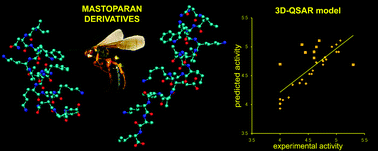More effective antimicrobial mastoparan derivatives, generated by 3D-QSAR-Almond and computational mutagenesis
Abstract
Antimicrobial

Maintenance work is planned for Wednesday 1st May 2024 from 9:00am to 11:00am (BST).
During this time, the performance of our website may be affected - searches may run slowly and some pages may be temporarily unavailable. If this happens, please try refreshing your web browser or try waiting two to three minutes before trying again.
We apologise for any inconvenience this might cause and thank you for your patience.
* Corresponding authors
a
University of Bucharest, Faculty of Biology, Dept. of Anatomy, Animal Physiology and Biophysics, 91-95 Spl. Independentei, Bucharest-076201, Romania
E-mail:
speranta@bio.unibuc.ro
Fax: 0040 213181573
Tel: 0040 740234158
b
“Politehnica” University of Bucharest, Faculty of Control and Computers, 313 Spl. Independentei, Bucharest-060042, Romania
E-mail:
cbuiu27@gmail.com
Fax: 0041 214029587
Tel: 0040 722360028
c
University of Medicine and Pharmacy “Victor Babes”, Biochemistry Dept., 2nd Eftimie Murgu Sq, Timisoara-300041, Romania
E-mail:
fborcan@umft.ro
Fax: 0040 356814179
Tel: 0040 722371025
d
Institute of Biochemistry of the Romanian Academy, 296th Spl. Independentei, Bucharest-060031, Romania
E-mail:
amilac@biochim.ro
Fax: 0040 212239068
Tel: 0040 212239069
Antimicrobial

 Please wait while we load your content...
Something went wrong. Try again?
Please wait while we load your content...
Something went wrong. Try again?
S. Avram, C. Buiu, F. Borcan and A. Milac, Mol. BioSyst., 2012, 8, 587 DOI: 10.1039/C1MB05297G
To request permission to reproduce material from this article, please go to the Copyright Clearance Center request page.
If you are an author contributing to an RSC publication, you do not need to request permission provided correct acknowledgement is given.
If you are the author of this article, you do not need to request permission to reproduce figures and diagrams provided correct acknowledgement is given. If you want to reproduce the whole article in a third-party publication (excluding your thesis/dissertation for which permission is not required) please go to the Copyright Clearance Center request page.
Read more about how to correctly acknowledge RSC content.
 Fetching data from CrossRef.
Fetching data from CrossRef.
This may take some time to load.
Loading related content
